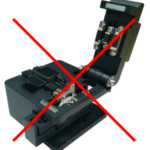Tutorials
How to cleave a fluoride fiber
Please note that because they are softer than silica, fluoride glass optical fibers are not compatible with standard cleaver devices.

How to cleave a fluoride fiber by hand :
This video shows how to cleave optical fibers by hand with a blade.
How to cleave a fluoride fiber with specialty cleaver device :
Several companies provide high precision cleaver devices compatible with soft glass.
For example : LDC401, LDC401A (Vytran series)

In order to use those cleaver devices, you will first have to strip fibers.
- Fluoride fibers: coated with polyacrylate, LVF stripping gel as described here can be used.
- Germanate fibers: coated with polyimide + hytrel, stripping gel cannot be used and another solution has to be prepared (ask us for information).
Most of cleaving devices are based on the tension-and-scribe process. You will find in the table below the tension range you should apply, depending on fiber cladding diameter, in order to get a flat and perpendicular cleave.
Fiber cladding diameter | ZFG | IFG | GeG |
|---|---|---|---|
125 µm | ≈ 90-100 g | ≈ 85-95 g | |
150 µm | ≈ 110-120 g | ≈ 100-110 g | |
260 µm | ≈ 220-260 g | ≈ 200-240 g | ≈ 200-240 g |
360 µm | ≈ 370-410 g | ≈ 340-380 g | |
460 µm | ≈ 500-540 g | ≈ 460-520 g | ≈ 500-560 g (500µm clad) |
680 µm | ≈ 670-730 g | ≈ 610-690 g |
